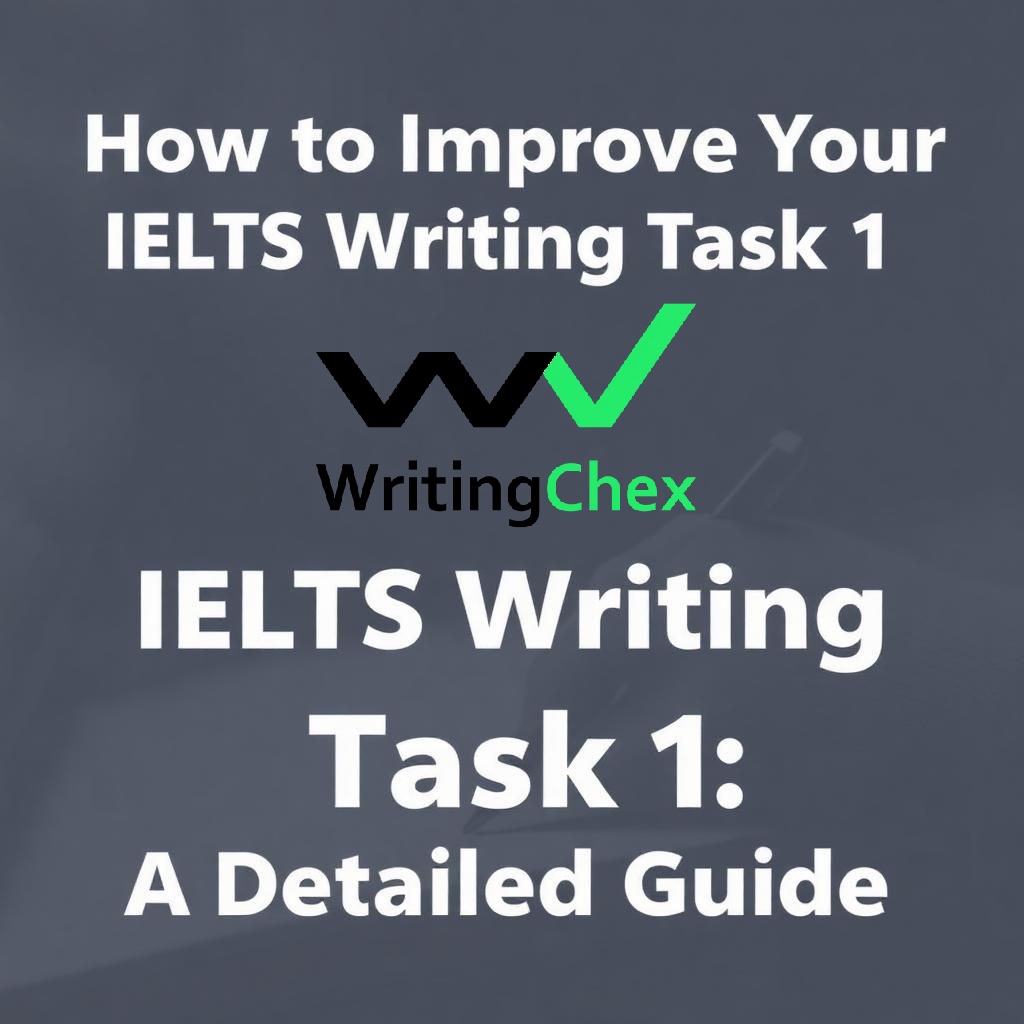IELTS Writing Task 1 is often seen as one of the more challenging aspects of the exam, especially for students who aren’t used to interpreting data or describing complex visuals. Here we provide your with tips to improve IELTS writing task 1. However, with the right strategies and clear understanding, you can easily improve your Task 1 writing skills and boost your score.
At WritingChex, we’ve helped many students refine their approach to Task 1, guiding them toward clearer, more precise writing. This post will provide you with a step-by-step guide to mastering Academic IELTS Writing Task 1, including tips on structure, vocabulary, and how to describe graphs, charts, and other visuals accurately.
1. Understand the Task Requirements
Know Exactly What You’re Asked to Do
In IELTS Writing Task 1, you’re required to write a report based on a given visual, such as a bar chart, pie chart, line graph, table, or diagram. The key to a high score in this section is understanding exactly what the question requires.
What You Need to Do:
- Identify the type of visual: Is it a bar chart, line graph, table, or map? Each type of visual requires a different approach to description.
- Understand the key data: Focus on the most important information in the visual. What trends or patterns can you identify?
- Don’t add personal opinions: Task 1 is a factual report, so avoid interpreting the data subjectively. Your goal is to objectively describe what is presented.
Tip from WritingChex: Before you start writing, spend a minute analyzing the visual. Identify the main trends (increase, decrease, stability), notable points, and any patterns that stand out.
2. Organize Your Writing into Clear Paragraphs
Structure Is Key for Clarity
One of the most critical aspects of Writing Task 1 is having a clear structure. A well-organized report will make your writing more readable and will help you achieve a higher score in the Coherence and Cohesion criteria.
What You Need to Do:
- Introduction: Paraphrase the task prompt to introduce the visual. Keep it simple and concise.
- Overview: This is a brief summary of the main trends or key features of the visual. Identify major increases, decreases, or stability.
- Body Paragraphs: Provide detailed descriptions of the data. Break it down into logical sections based on what the visual shows (e.g., describing one trend in one paragraph and another in the next).
Tip from WritingChex: Use linking words like “in contrast,” “similarly,” or “on the other hand” to connect ideas between paragraphs and create a smooth flow in your writing.
3. Focus on Data, Not Details
Stick to the Important Data
A common mistake that students make in Task 1 is getting caught up in minor details, such as exact numbers or dates. While it’s essential to provide accurate information, it’s equally important to focus on the trends and key points rather than overwhelming the reader with unnecessary figures.
What You Need to Do:
- Summarize the key trends: For example, instead of writing about every small fluctuation, focus on major increases, decreases, or trends.
- Use approximations: For example, instead of saying “the number of cars sold increased by 3.5%,” you can say “there was a slight increase in car sales” or “sales increased modestly.”
Tip from WritingChex: When describing percentages, use expressions like “approximately,” “about,” or “roughly” to give a general idea without overwhelming the reader with unnecessary specifics.
4. Use Accurate and Varied Vocabulary
Vocabulary Variety Will Help You Score Higher
In IELTS Writing Task 1, you need to demonstrate a range of vocabulary, particularly when describing trends. Using a limited range of words or repeating the same expressions (e.g., “increase” or “decrease”) can lower your score.
What You Need to Do:
- Use synonyms for trends: Instead of repeating the word “increase,” you can use alternatives like “rise,” “grow,” “climb,” “surge,” or “go up.” Similarly, for “decrease,” try “fall,” “drop,” “decline,” or “dip.”
- Use precise language: For example, instead of simply saying “it went up,” you could say “there was a significant rise,” or “the number of students rose dramatically.”
Tip from WritingChex: Use more formal academic language. Avoid casual terms and phrases. Task 1 requires an objective and professional tone, so avoid conversational expressions like “got bigger” or “went down a lot.”
5. Pay Attention to Grammar and Sentence Variety
Grammar Accuracy and Sentence Structure Matter
Strong grammar and sentence variety are crucial for scoring well in IELTS Writing Task 1. Using a mixture of simple and complex sentences will help demonstrate your grammatical range. It’s also essential to ensure your grammar is correct—small errors can lower your score significantly.
What You Need to Do:
- Vary your sentence structures: Mix simple, compound, and complex sentences. For example, “The number of tourists increased by 10% last year. This was followed by a decrease in the following year” is a simple sentence structure. You could improve it by combining it into a more complex sentence: “The number of tourists increased by 10% last year, before experiencing a slight decrease in the subsequent year.”
- Use correct tenses: Most IELTS Task 1 visuals are in the past tense, but some might show future predictions (like in a projection). Be mindful of the tense you use based on the data shown.
Tip from WritingChex: Practice writing sentences of different complexities. This not only improves your writing but also boosts your grammatical range.
6. Avoid Common Mistakes
Be Aware of These Pitfalls
There are several common mistakes students often make in Writing Task 1. These can hurt your score, so it’s crucial to avoid them.
What You Need to Do:
- Don’t describe every detail: As mentioned earlier, focus on the trends, not every minor fluctuation.
- Don’t include personal opinions: Task 1 is about objective description, not analysis or opinions.
- Don’t repeat the same structure: Variety is key in Task 1. Don’t use the same pattern for every visual description. Try to switch up the structure based on what’s presented.
Tip from WritingChex: Take time to review your writing. After completing Task 1, reread your essay to ensure you’re sticking to the requirements—objectivity, clarity, and accuracy.
How WritingChex Can Help You Improve Your IELTS Writing Task 1
At WritingChex, we specialize in providing detailed feedback on IELTS Writing tasks. Our expert team can help you analyze your Task 1 responses, pointing out areas for improvement in structure, vocabulary, grammar, and overall clarity.
If you’re struggling with how to describe trends or need help using a wider range of vocabulary, our feedback will help guide you in the right direction. We also offer personalized practice sessions where you can submit your Task 1 responses for detailed corrections and tips.
Final Thoughts
IELTS Writing Task 1 doesn’t have to be intimidating. With the right approach, clear structure, and strong vocabulary, you can easily master this section and score high. Focus on understanding the task requirements, using varied language, and structuring your writing logically.
By following the steps outlined above, you’ll be well on your way to improving your performance in Task 1 and achieving your desired band score. And don’t forget—WritingChex is here to provide expert feedback and help you refine your skills.
Good luck with your preparation, and keep practicing!



